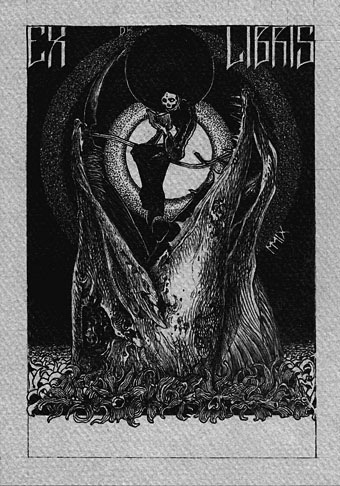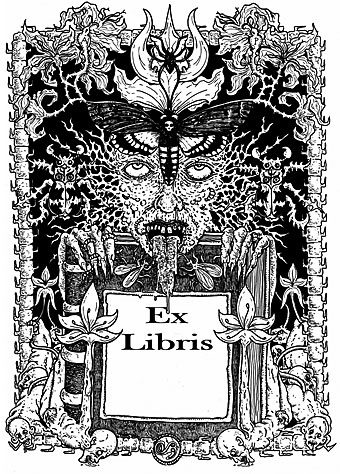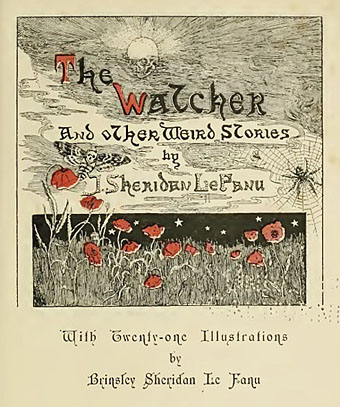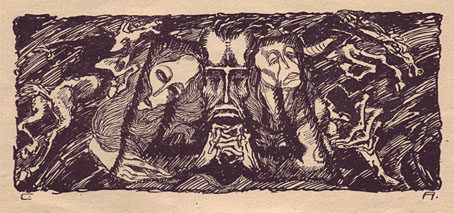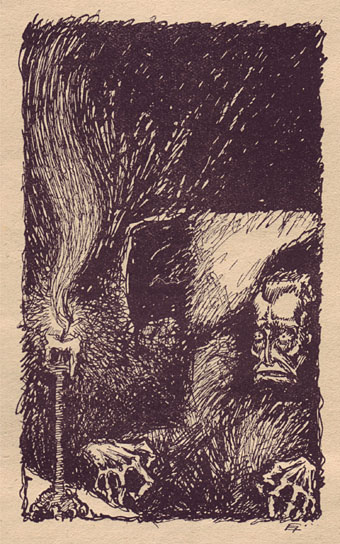Clouzot’s towering inferno | A film called Hell.
Month: October 2009
A playlist for Halloween: Voodoo!
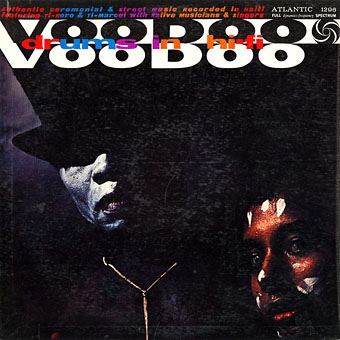
It’s become a tradition here to post a playlist for Halloween so here’s the one for this year, a collection of favourite “voodoo” music. Most are these pieces have as much to do with real voodoo as Bewitched does with real witchcraft but I like the atmospheres of Voodoo Exotica they evoke.
Voodoo Drums in Hi-Fi (1958).
Beginning with some ethnographic authenticity, this is one of many recordings of genuine (so they claim) voodoo drummers from Haiti, and was probably released to cash-in on the Exotica boom of the late Fifties. For the genuine article, the drums here sound less dramatic than the pounding rhythms familiar from Hollywood rituals, but that’s still a great cover. Voodoo Drums in Hi-Fi has been deleted for years but a worn copy of the vinyl release can be found on various mp3 blogs. For a more recent recording of voodoo rhythms, there’s Spirits Of Life: Haitian Vodou on the Soul Jazz label.
Voodoo Dreams (1959) by Martin Denny.
This, meanwhile, is the genuine kitsch from Denny’s Hypnotique album, a slow arrangement of a syrupy Les Baxter tune. More drums and bongos than usual for a Denny piece, and a suitably spectral chorus.
Voodoo (1959) by Robert Drasnin.
When composer Drasnin was asked by the Tops company to get hip to the Exotica craze the result was an album entitled Voodoo (with unconvincingly exotic white people on the cover), from which they released a single, Chant of the Moon, and this track as the B-side, one of the best pieces on the album.
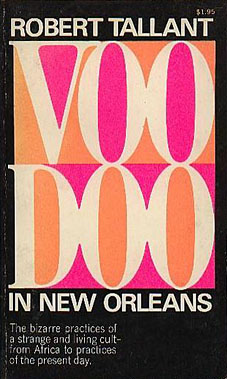
I Walk on Gilded Splinters (1968) by Dr John.
Mac Rebennack was working as a session musician in Los Angeles when he recorded his debut album in an atmosphere far removed from the swampy New Orleans miasma which the music conjures. Gris-Gris owes a great deal to Robert Tallant’s book, Voodoo in New Orleans (1946), a popular recounting of the city’s occult legends from which Rebennack borrowed not only his new persona (chapter 5 concerns the history of the real Dr John, a 19th century voodoo practitioner) but also many of the transcribed chants which he set to music. In chapter 3 we read this:
A song given to a reporter of the New Orleans Times-Picayune was printed in that newspaper on March 16, 1924. Probably a very old one, it reflects the dominance of the queens in New Orleans Voodoo and boasts of their tremendous power. Originally sung in the patois known as Creole, it is given here in English:
They think they frighten me,
Those people must be crazy.
They don’t see their misfortune
Or else they must be drunk.I—the Voodoo Queen,
With my lovely headkerchief
Am not afraid of tomcat shrieks,
I drink serpent venom!I walk on pins
I walk on needles,
I walk on gilded splinters,
I want to see what they can do!They think they have pride
With their big malice,
But when they see a coffin
They’re as frightened as prairie birds.I’m going to put gris-gris
All over their front steps
And make them shake
Until they stutter!
Anyone familiar with Gris-Gris will recognise the lyrics of I Walk on Gilded Splinters (misspelled “Guilded” on the sleeve) which Dr John did a great job of fashioning into a classic voodoo song. The entire album might be ersatz, then, but it remains one of my favourites by anyone, and for me it’s still the best Dr John album.
Mama Loi, Papa Loi (1970) by Exuma.
Gris-Gris was too weird to be a success when it first appeared but Dr John’s music and extravagant stage presence were very distinctive and helped Blues Magoos manager Bob Wyld recast singer Tony McKay as “Obeah man” Exuma for Mercury Records. Exuma’s self-titled debut album is ersatz stuff again but manages to sound even more deliriously swampy and sorcerous than Gris-Gris, with jungle sounds, zombie gurgles and a clutch of enthusiastic voodoo-inflected songs. “Mama Loi, Papa Loi / I see fire in the dead man’s eye” he sings here, and for the duration of the album Tony McKay is Exuma.
Zu Zu Mamou (1971) by Dr. John.
After Gris-Gris Dr John gradually pared away the voodoo songs but saved one of the best until his final occult outing, The Sun, Moon & Herbs, which includes contributions from Eric Clapton and, somewhere in the bayou distance, Mick Jagger and PP Arnold on backing vocals. Zu Zu Mamou is the spooky highlight which made a fleeting appearance in Alan Parker’s 1987 Satanic noir, Angel Heart.
Voo Doo (1989) by the Neville Brothers.
Of all the songs I’ve heard which equate falling in love with a voodoo spell, this one from New Orleans’ Neville Brothers is the most evocative, a track from their marvellous Yellow Moon album.
Invocation To Papa Legba (1989) by Deborah Harry.
Yes, it’s Blondie’s Debbie Harry singing a very authentic-sounding voodoo chant, arranged by Chris Stein. This was a one-off which appeared on a Giorno Poetry Systems collection, Like A Girl, I Want You To Keep Coming, along with a William Burroughs reading (a staple of GPS albums), New Order playing Sister Ray live, and other pieces.
Litanie Des Saints (1992) by Dr. John.
Goin’ Back to New Orleans, like Gumbo before it, saw Dr John revisiting the musical history of his native city. Most of the songs are old jazz and blues covers with the notable exception of this opening number, another voodoo invocation. A great string arrangement and vocals from the Neville Brothers; I’d love to hear a whole album like this.
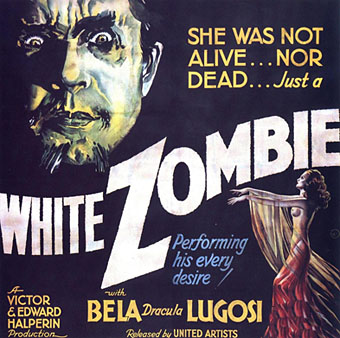
Zombie’ites (1993) by Transglobal Underground.
Zombies are a voodoo staple despite their current degraded status as the cuddly monster du jour, a development which has made me tire of seeing the word “zombie” in almost any context. A shame because I used to have a lot of time for films such as White Zombie (1932), I Walked With a Zombie (1943), and the later George Romero movies. White Zombie was the first zombie film and stars Bela Lugosi in a weirder and more effective piece of horror cinema than the stagey Dracula which made his name; I Walked With a Zombie was one of Val Lewton’s superb noirish collaborations with Jacques Tourneur; both films have their voodoo chants sampled on this track by Transglobal Underground from Dream of 100 Nations, with the opening chant from White Zombie forming the pulse that drives the piece. Along the way there’s another invocation from Voodoo in New Orleans—”L’Appé vini, le Grand Zombi / L’Appé vini, pou fe gris-gris!”—samples of Criswell from Plan 9 from Outer Space, and a moment of pure bliss at the midpoint when singer Natacha Atlas rides in on a magic carpet made of Bollywood strings.
Happy Halloween! And don’t forget to feed the loas…
• Vampire-hunting in New Orleans
Previously on { feuilleton }
• Voo-doo: Hoochie Coochie and the Creative Spirit
• Dead on the Dancefloor
• Another playlist for Halloween
• Exotica!
• White Noise: Electric Storms, Radiophonics and the Delian Mode
• The Séance at Hobs Lane
• Exuma: Obeah men and the voodoo groove
• A playlist for Halloween
• Ghost Box
• Voodoo Macbeth
The Evil Orchid Bookplate Contest
Bookplate by Denis Kostromitin.
Following the recent postings of covers and illustrations from Der Orchideengarten, Will at A Journey Round My Skull posts the results of his Evil Orchid Bookplate Contest which encouraged illustrators to create an Orchideengarten-styled bookplate design. You can see the winner and many other splendid entries on his pages. I fully intended to do something for this then got sidetracked by work on the Alice in Wonderland calendar but I’ve picked out a couple of the (inevitably) black-and-white pieces which I thought stood out. The death’s-head moth on @ndy paciorek’s picture below makes a convenient link with yesterday’s post.
Meanwhile, there’s further Orchideengarten goodness over at Arthur Magazine.
Bookplate by @ndy paciorek.
Elsewhere on { feuilleton }
• The illustrators archive
Previously on { feuilleton }
• Der Orchideengarten illustrated
• David Becket’s bookplates
• Der Orchideengarten
The Watcher and Other Weird Stories by J. Sheridan Le Fanu
Irish writer J. Sheridan Le Fanu (1814–1873) has long been a favourite of mine since I first discovered his weird tales in ghost story collections, still the place you’re most likely to find his work. His ghost stories are frequently superior to the more celebrated MR James (who edited a Le Fanu collection), they’re less formulaic and often quite inexplicable. Green Tea, from In a Glass Darkly (1872) chills for its atmosphere of apparently random and unjustified malevolence; it’s also alarming for the directness of its central idea which I won’t spoil if you haven’t read it. Anyone wanting to know why Le Fanu is still read today should start there.
Unlike MR James, Le Fanu has lacked for illustrators so I was surprised to find this edition of his work at the Internet Archive with illustrations by his son, Brinsley. The artwork isn’t of the highest quality, and it’s debatable whether tales as nebulous and evocative as ghost stories should be illustrated at all, but their singularity makes them worth a look. The Watcher and Other Weird Stories is a small collection which includes A Strange Event in the Life of Schalken the Painter, a story memorably adapted for television by Leslie Megahey in 1979.
Previously on { feuilleton }
• Chiaroscuro
Der Orchideengarten illustrated
Halloween approaches and as a precursor it’s a great pleasure to be able to post a selection of interior illustrations from Der Orchideengarten, courtesy of Will at A Journey Round My Skull. Der Orchideengarten was a German magazine of weird fiction which ran for 51 issues from 1919 to 1921 and whose existence today is rarely acknowledged despite being credited as the world’s first fantasy magazine. Information is scarce and these scans come from Will’s own copies which is why I’ve posted fifteen more below the fold; you can’t see this stuff anywhere else. A Journey Round My Skull featured some covers and a different set of interior illustrations earlier this year, and there should be a new post complementing this one with more of the magazine’s stunning cover designs.
What strikes me about these black-and-white drawings is how different they are in tone to the pulp magazines which followed shortly after in America and elsewhere. They’re at once far more adult and frequently more original than the Gothic clichés which padded out Weird Tales and lesser titles for many years. Some are almost Expressionist in style, while the Wild Hunt series below shows a distinct Goya influence. I’d love to know how the written content matches the illustrations; I suspect there’s the same difference of atmosphere and emphasis to American weird fiction as there is in the drawings.
Update: Will’s new post is Watering the Toxic Garden which will be followed on Thursday by the results of his Evil Orchid Bookplate Contest.
Click on any of these pictures for a larger version.

